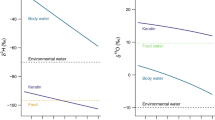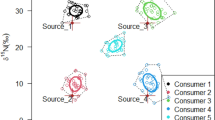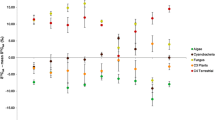Abstract
Stable isotope analysis of consumer tissues document patterns of resource use because data are linearly related to isotope compositions of their source(s) (i.e., food, water, etc.). Deviations in parameters estimated for these relationships can arise from variations in consumer tissue–diet spacing (Δ TS ) and the level of isotopic heterogeneity in the source(s). We present a set of simple hypotheses that distinguish between the effects of Δ TS and source isotope heterogeneity. The latter may arise via mixed diets, during tissue turnover, or by isotopic routing of dietary components. We apply these concepts to stable carbon and nitrogen isotope relationships between gut contents and body tissues of large mammal herbivores from mixed C3/C4 South African savannas and test predictions based on the compound- and/or time-specific data archived within each material. Predicted effects of source isotope heterogeneity are readily detected in carbon isotope relationships between materials representing different time periods or comprising bulk versus protein-only diet components. Differences in Δ TS of carbon isotopes across mammal herbivore species with very different feeding niches (and diet isotope compositions) are likely to be small or non-existent in these habitats. Variations in Δ TS estimated for nitrogen isotopes are much greater, leading to inconsistencies that cannot be explained by diet or trophic level effects alone. The effects of source heterogeneity on isotopic relationships generate numerical artefacts that have been misinterpreted as variations in Δ TS . We caution against generalized application of hypotheses based on assumptions of source isotopic homogeneity, even for single diets commonly used in laboratory studies. More careful consideration of how heterogeneity affects consumer–diet relationships is needed for many field and laboratory systems.




Similar content being viewed by others
References
Ambrose SH, Norr L (1993) Experimental evidence for the relationship of the carbon isotope ratios of whole diet and dietary protein to those of bone collagen and carbonate. In: Lambert JB, Grupe G (eds) Prehistoric human bone: archaeology at the molecular level. Springer-Verlag, Berlin, pp 1–37
Auerswald K, Wittmer MHOM, Zazzo A, Schäufele R, Schnyder H (2010) Biases in the analysis of stable isotope discrimination in food webs. J Appl Ecol 47:936–941
Ayliffe LK, Cerling TE, Robinson T, West AG, Sponheimer M, Passey BH, Hammer J, Roeder B, Dearing MD, Ehleringer JR (2004) Turnover of carbon isotopes in tail hair and breath CO2 of horses fed an isotopically varied diet. Oecologia 139:11–22
Bauchinger U, McWilliams S (2009) Carbon turnover in tissues of a passerine bird: allometry, isotopic clocks, and phenotypic flexibility in organ size. Physiol Biochem Zool 82:787–797
Bearhop S, Waldron S, Votier SC, Furness RW (2002) Factors that influence assimilation rates and fractionation of Nitrogen and Carbon stable isotopes in avian blood and feathers. Physiol Biochem Zool 75:451–458
Caut S, Angulo E, Courchamp F (2008) Discrimination factors (Δ15N and Δ13C) in an omnivorous consumer: effect of diet isotopic ratio. Funct Ecol 22:255–263
Caut S, Angulo E, Courchamp F (2009) Variation in discrimination factors (Δ15 N and Δ13C): the effect of diet isotopic values and applications for diet reconstruction. J Appl Ecol 46:443–453
Caut S, Angulo E, Courchamp F, Figuerola J (2010) Trophic experiments to estimate isotope discrimination factors. J Appl Ecol 47:948–954
Cerling TE, Harris JM (1999) Carbon isotope fractionation between diet and bioapatite in ungulate mammals and implications for ecological and paleoecological studies. Oecologia 120:347–363
Cerling T, Ayliffe L, Dearing M, Ehleringer J, Passey B, Podlesak D, Torregrossa A-M, West A (2007) Determining biological tissue turnover using stable isotopes: the reaction progress variable. Oecologia 151:175–189
Clauss M, Kaiser T, Hummel J (2008) The morphophysiological adaptations of browsing and grazing mammals. In: Gordon IJ, Prins HHT (eds) The ecology of browsing and grazing. Springer, Heidelberg, pp 47–88
Clauss M, Lechner I, Barboza P, Collins W, Tervoort TA, Südekum K-H, Codron D, Hummel J (2011) The effect of size and density on the mean retention time of particles in the reticulorumen of cattle (Bos primigenius f. taurus), muskoxen (Ovibos moschatus) and moose (Alces alces). Br J Nutr 105:634–644
Codron D, Clauss M (2010) Rumen physiology constrains diet niche: linking digestive physiology and food selection across wild ruminant species. Can J Zool 88:1129–1138
Codron D, Lee-Thorp JA, Sponheimer M, Codron J (2007) Stable carbon isotope reconstruction of ungulate diet changes through the seasonal cycle. S Afr J Wildl Res 37:117–125
Codron D, Codron J, Sponheimer M, Bernasconi SM, Clauss M (2011) When animals are not quite what they eat: diet digestibility influences 13C-incorporation rates and apparent discrimination in a mixed-feeding herbivore. Can J Zool 89:453–465
Codron D, Sponheimer M, Codron J, Hammer S, Tschuor A, Braun U, Bernasconi SM, Claus M (2012) Tracking the fate of digesta 13C and 15N compositions along the ruminant gastrointestinal tract: does digestion influence the relationship between diet and faeces? Eur J Wildl Res 58:303–313
Craig H (1954) Carbon-13 in plants and the relationships between carbon-13 and carbon-14 variations in nature. J Geol 62:115–149
DeNiro E (1978) Influence of diet on the distribution of carbon isotopes in animals. Geochem Cosmochim Acta 42:495–506
DeNiro E (1981) Influence of diet on the distribution of nitrogen isotopes in animals. Geochem Cosmochim Acta 45:341–351
du Toit JT (2003) Large herbivores and savanna heterogeneity. In: du Toit JT, Rogers KH, Biggs HC (eds) The Kruger experience: ecology and management of savanna heterogeneity. Island Press, Washington DC, pp 292–309
Felicetti LA, Schwartz CC, Rye RO, Haroldson MA, Gunther KA, Phillips DL, Robbins CT (2003) Use of sulfur and nitrogen stable isotopes to determine the importance of whitebark pine nuts to Yellowstone grizzly bears. Can J Zool 81:763–770
Flaherty EA, Ben-David M (2010) Overlap and partitioning of the ecological and isotopic niches. Oikos 119:1409–1416
Gagnon M, Chew AE (2000) Dietary preferences in extant African Bovidae. J Mammal 81:490–511
Heckathorn SA, McNaughton SJ, Coleman JS (1999) C4 plants and herbivory. In: Sage RF, Monson RK (eds) C4 plant biology. Academic press, San Diego, pp 285–312
Hilderbrand GV, Farley SD, Robbins CT, Hanley TA, Titus K, Servheen C (1996) Use of stable isotopes to determine diets of living and extinct bears. Can J Zool 74:2080–2088
Hobson KA (1999) Tracing origins and migration of wildlife using stable isotopes: a review. Oecologia 120:314–326
Hobson KA, Clark RG (1992) Assessing avian diets using stable isotopes I: turnover of 13C in tissues. Condor 94:181–188
Hobson KA, Atwell L, Wassenaar LI, Yerkes T (2004) Estimating endogenous nutrient allocations to reproduction in redhead ducks: a dual isotope approach using δD and δ13C measurements of female and egg tissues. Funct Ecol 18:737–745
Hood GM (2008) PopTools v3.0.6. CSIRO, Australia. Available at: http://www.cse.csiro.au/poptools/
Hummel J, Südekum K-H, Streich WJ, Clauss M (2006) Forage fermentation patterns and their implications for herbivore ingesta retention times. Funct Ecol 20:989–1002
Hwang YT, Millar JS, Longstaffe FJ (2007) Do δ15 N and δ13C values of feces reflect the isotopic composition of diets in small mammals? Can J Zool 85:388–396
Layman CA, Arrington DA, Montańa CG, Post DM (2007) Can stable isotope ratios provide for community-wide measures of trophic structure? Ecology 88:42–48
Lechner I, Barboza P, Collins W, Fritz J, Günther D, Hattendorf B, Hummel J, Südekum K-H, Clauss M (2010) Differential passage of fluids and different-sized particles in fistulated oxen (Bos primigenius f. taurus), muskoxen (Ovibos moschatus), reindeer (Rangifer tarandus) and moose (Alces alces): rumen particle size discrimination is independent from contents stratification. Comp Biochem Physiol A 155:211–222
Martínez del Rio C, Anderson-Sprecher R (2008) Beyond the reaction progress variable: the meaning and significance of isotopic incorporation data. Oecologia 156:765–772
Martínez del Rio C, Wolf N, Carleton SA, Gannes LZ (2009) Isotopic ecology ten years after a call for more laboratory experiments. Biol Rev 84:91–111
Matthews B, Mazunder A (2004) A critical evaluation of intrapopulation variation of δ13C and isotopic evidence of individual specialization. Oecologia 140:361–371
Murphy BP, Bowman DMJS (2006) Kangaroo metabolism does not cause the relationship between bone collagen δ15 N and water availability. Funct Ecol 20:1062–1069
Newsome SD, Martinez del Rio C, Bearhop S, Phillips DL (2007) A niche for isotopic ecology. Front Ecol Environ 5:429–436
Newsome SD, Bentall GB, Tinker MT, Oftedal OT, Ralls K, Estes JA, Fogel ML (2010) Variation in δ13C and δ15 N diet–vibrissae trophic discrimination factors in a wild population of California sea otters. Ecol Appl 20:1744–1752
Passey BH, Robinson TF, Ayliffe LK, Cerling TE, Sponheimer M, Dearing MD, Roeder BL, Ehleringer JR (2005) Carbon isotope fractionation between diet, breath CO2, and bioapatite in different animals. J Archaeol Sci 32:1459–1470
Perga M-E, Grey J (2010) Laboratory measures of isotope discrimination factors: comments on Caut, Angulo and Courchamp (2008, 2009). J Appl Ecol 47:942–947
Phillips D, Eldridge P (2006) Estimating the timing of diet shifts using stable isotopes. Oecologia 147:195–203
Post DM (2002) Using stable isotopes to estimate trophic position: models, methods, and assumptions. Ecology 83:703–718
Robbins C, Felicetti L, Florin S (2010) The impact of protein quality on stable nitrogen isotope ratio discrimination and assimilated diet estimation. Oecologia 162:571–579
Rutherford MC, Westfall RH (1994) Biomes of southern Africa: an objective classification. In: Memoirs of the botanical survey of South Africa. National Botanical Institute, Pretoria, pp 63–94
Sealy JC, van der Merwe NJ, Lee-Thorp JA, Lanham JL (1987) Nitrogen isotopic ecology in southern Africa: implications for environmental and dietary tracing. Geochim Cosmochim Acta 51:2707–2717
Skinner JD, Smithers RHN (1990) The mammals of the southern African subregion, 2nd edn. University of Pretoria, Pretoria
Sponheimer M, Lee-Thorp JA, de Ruiter DJ, Smith JM, van der Merwe NJ, Reed K, Grant CC, Ayliffe LK, Robinson TF, Heidelberger C, Marcus W (2003a) Diets of southern African Bovidae: stable isotope evidence. J Mammal 84:471–479
Sponheimer M, Robinson T, Ayliffe L, Roeder B, Hammer J, Passey B, West A, Cerling T, Dearing D, Ehleringer J (2003b) Nitrogen isotopes in mammalian herbivores: hair δ15 N values from a controlled feeding study. Int J Osteoarchaeol 13:80–87
Statsoft_Inc (2007) STATISTICA version 8.0 (data analysis software system). Statsoft Inc, Tulsa. Available at:http://www.statsoft.com
Tieszen L, Hein D, Qvortrup D, Troughton J, Imbamba S (1979) Use of δ13C values to determine vegetation selectivity in east African herbivores. Oecologia 37:351–359
Tieszen LL, Boutton TW, Tesdahl KG, Slade NA (1983) Fractionation and turnover of stable carbon isotopes in animal tissues: implications for δ13C analysis of diet. Oecologia 57:32–37
Vogel JC (1978) Isotopic assessment of the dietary habits of ungulates. S Afr J Sci 74:298–301
Wattiaux MA, Reed JD (1995) Fractionation of nitrogen isotopes by mixed ruminal bacteria. J Anim Sci 73:257–266
Wittmer MHOM, Auerswald K, Schönbach P, Schäufele R, Müller K, Yang H, Bai YF, Susenbeth A, Taube F, Schnyder H (2010) Do grazer hair and faeces reflect the carbon isotope composition of semi-arid C3/C4 grassland? Basic Appl Ecol 11:83–92
Acknowledgments
We thank J. Brink, S. Vrahmis, F. Malie, E. Codron, T. Boleme, I. Thapo, P. Mdala, A. Thibeletsa, B. Nduma, A. Dichakane, and S. Dlamini for assisting with the fieldwork. Scott McWilliams, Karl Auerswald, and two anonymous reviewers are thanked for comments on an earlier version. The study was approved by the animal ethics committee of the University of KwaZulu-Natal, and by the Free State Department of Tourism, Environmental and Economic Affairs. Funding was provided by the European Union (Marie-Curie PIIF-GA-2009-236670), the Swiss National Fund (IZ32Z0-125787), the National Research Foundation of South Africa, the University of KwaZulu-Natal, the National Museum, and the Palaeontological Scientific Trust of South Africa.
Author information
Authors and Affiliations
Corresponding author
Additional information
Communicated by Scott McWilliams.
Electronic supplementary material
Below is the link to the electronic supplementary material.
Rights and permissions
About this article
Cite this article
Codron, D., Sponheimer, M., Codron, J. et al. The confounding effects of source isotopic heterogeneity on consumer–diet and tissue–tissue stable isotope relationships. Oecologia 169, 939–953 (2012). https://doi.org/10.1007/s00442-012-2274-3
Received:
Accepted:
Published:
Issue Date:
DOI: https://doi.org/10.1007/s00442-012-2274-3




